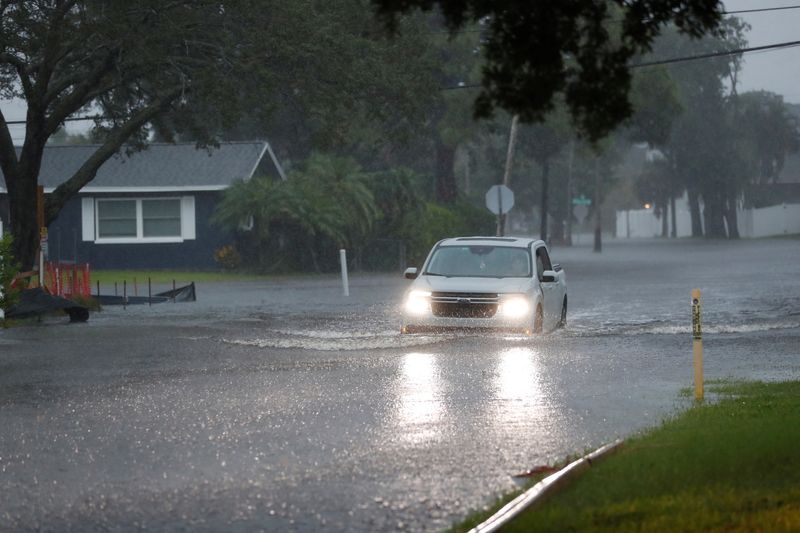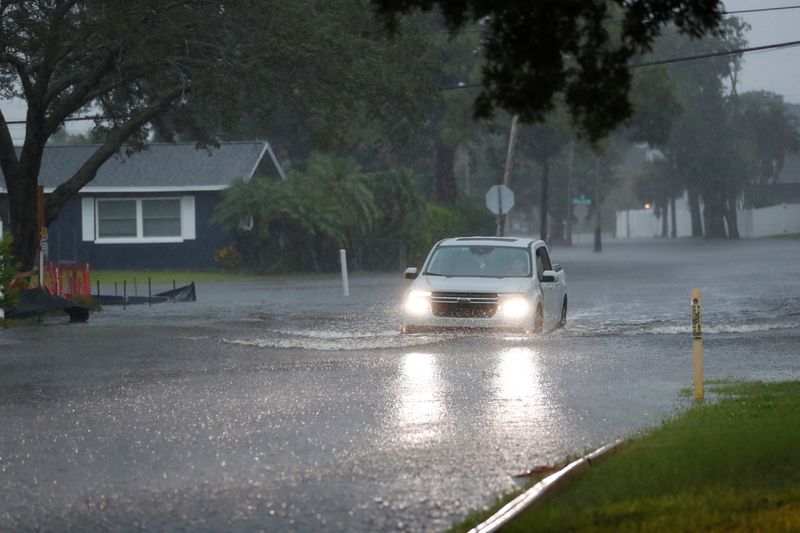
By Rich McKay
(Reuters) -Hurricane Debby made landfall as a Category 1 storm in the Big Bend region of Florida’s Gulf Coast on Monday morning and began a slow crawl across the state, where it could trigger dangerous storm surges, heavy rainfall and catastrophic flooding.
The hurricane slammed ashore near Steinhatchee, Florida, about 70 miles (115 km) southeast of Tallahassee, packing maximum sustained winds of 80 mph (130 kph), the National Hurricane Center said.
Debby has already dumped up to a foot of rain in some parts of the southwest part of the state, Florida Division of Emergency Management Executive Director Kevin Guthrie said. Roughly 223,500 customers have lost power in the state, according to Poweroutage.us.
Florida Governor Ron DeSantis said the state was approved for federal disaster assistance on Sunday and that 17,000 crew members are on hand to restore power.
The storm has the potential to bring historically heavy rainfall across southeast Georgia and coastal South Carolina through Saturday morning, likely resulting in severe flooding, the NHC said.
“This is going to be event that is going to be probably here for the next five to seven days maybe as long as 10 days depending on how much rainfall we get,” Guthrie said.
The hurricane center forecast life-threatening conditions, including storm surges up to 10 feet (3 meters) in some areas. Local areas could receive more than two feet of rain by Friday morning.
A slow-moving tropical storm as it passed over Cuba, Debby gained strength from exceptionally warm Gulf waters as it paralleled Florida’s Gulf Coast.
“This is going to be the story of this storm,” said Jamie Rhome, the deputy director of the hurricane center. “It’s slow motion is going to dump historic amounts of rainfall – potentially over 20 inches.”
Debby bears some of the hallmarks of Hurricane Harvey, which hit Corpus Christi, Texas, in August 2017. While Harvey was downgraded into a tropical storm as it moved inland, it lingered over the state, dumping about 50 inches of rain on Houston.
Harvey is rated as one of the wettest storms in U.S. history, causing more than 100 deaths and $125 billion in damage, primarily from flooding in the Houston metropolitan area.
Climate scientists believe man-made global warming from burning fossil fuels has raised the temperature of the oceans, making storms bigger and more devastating.
Preparing for Debby, DeSantis called up 3,000 National Guard troops and placed most of the state’s cities and counties under emergency orders, while mandatory evacuations were ordered in parts of the Gulf Coast counties of Citrus, Dixie, Franklin, Levy and Wakulla.
HEAVY RAIN
The storm is expected to bring heavy rain as it crosses central Florida out to the Atlantic coast, before crawling up to Savannah, Georgia, and then onward to Charleston, South Carolina, while dumping huge amounts of rain.
The last hurricane to make a direct hit on the Big Bend region was Hurricane Idalia, which briefly gained Category 4 strength before making landfall as a Category 3 in August 2023, with winds of more than 125 mph. The National Centers for Environmental Information estimates there were $3.5 billion in damages. DeSantis described the initial effects of Debby as “modest” compared with Idalia.

Forecasters expect numerous Atlantic hurricanes in the 2024 season, which began on June 1, with four to seven seen as major. That exceeds the record-breaking 2005 season that spawned the devastating Katrina and Rita hurricanes.
Only one hurricane, Beryl, has yet formed in the Atlantic this year. The earliest Category 5 storm on record, it struck the Caribbean and Mexico’s Yucatan peninsula before rolling up the Gulf Coast of Texas as a Category 1 storm, with sustained winds up to 95 mph.
This post is originally published on INVESTING.




